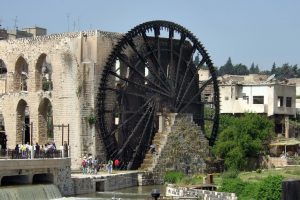
Hama is one of the oldest residential areas in the Middle East.
Archaeological missions indicate that the Asi River basin was a hotbed of primitive life and ancient stone man with evidence of finding tools, relics and habitation dating back to prehistoric times throughout the province.
Studies conducted by the Danish Archaeological Mission led by Harold Angult, who conducted excavations at Hama Castle between 1931 and 1938, have shown that there are thirteen strata that have passed through the city.
The first layer dates back to the Neolithic period (5th millennium BC), while the most recent date dates back to the fourteenth century AH (8th AH) …..
Hence, the history of Hama known is due to seven thousand years, which made it _ and through scientific studies _ one of the oldest cities on the surface of the globe, which is still alive in its spring ….. if not the oldest at all.
The area of the city of Hama is about 10000 km2 and its population is about 2.1 million people (according to 2011 statistics)
It is a wonderful combination of plains, mountains and valleys, through which the stream of the Orontes River flows along the length of 171 km of green, along with lush forests, flowing springs, houses and museums distinguished by its special construction. It sleeps calmly in the embrace of glamorous nature with paintings, inscriptions and shadows. The country is connected by an international network of roads, railways and the varied climate of Hama governorate, which is varied between the mountains with its refreshing resorts, mild plains, and the desert with its warmth and bright sun.
And we do not promise the truth if we say that the province of Hama is one of the wealthiest provinces of the Syrian Arab Republic, with antiquities dating back to prehistoric times and extending to successive times to our present day.
There are wide squares, wide streets, modern neighborhoods, international hotels, fine restaurants with bright stars, laboratories, institutions, productive companies and modern laboratories.
Norias of Hama


The fountain is a wooden wheel surrounded by the outside boxes with a side opening, which drips the water during the entry of part of the fountain under the water and raise it to the point of peak and put it in the stone to reach the areas used.
In the past, there were more than 100 waterwheels in Hama, each with its own name. It also has different standards for the diameter, height and size of its heart.
Most of the wood used in the construction of Waterwheel is made of walnut wood, some of which are used in oak, raspberry, apricot and spinach.
And their parts are fixed together with iron nails in different lengths and thicknesses according to the sections of Waterwheel.
Each part of the passage through its center plays its own role, and any defect or change in these parts leads to imbalance and crash when rotated so the spinning industry needs sufficient experience.
Waterwheel also needs permanent maintenance in order to remain healthy and in good condition.
The diameter of some of these twigs (21) m and used in the manufacture of (50) tons of wood and the amount of special iron nails ranging in length (4_60) cm and weighing (500) kg.
The most important monuments in Hama Governorate

Cultural Tourism: Afamek_Kasar Ibn Wardan_ Monastery of the Cross _ family _ Andrin_ Palace Azem_ Khan Rustam Pasha (market handicrafts) in addition to 12 archaeological fort.
Religious Tourism: Grand Mosque of the Great _ Mosque of the light_ Mosque of Abu al-Fida_ Mosque of Al-Hassanein_ Church of Our Lady of Entry_ Church of St. George_ Maqam Zine El Abidine_ Imam Ismail shrine.
Tourism and tourism: the banks of the river Oasi_ Musayaf_ Valley of the eyes _ Wadi Abu Qabis_ Nahr al-Bared_ Barchin_ mill Halawa.

 English
English العربية
العربية المؤتمر الطبي الدولي الثاني جامعة حماة
المؤتمر الطبي الدولي الثاني جامعة حماة